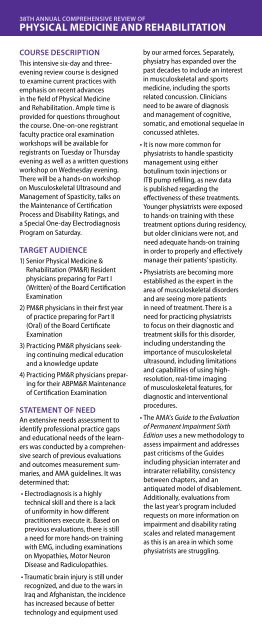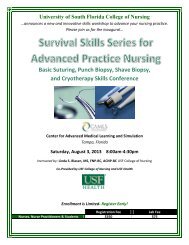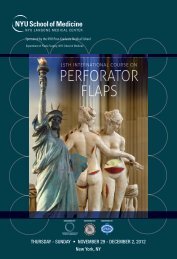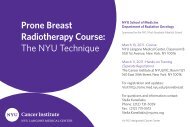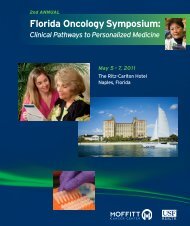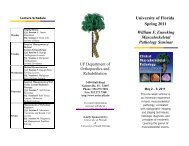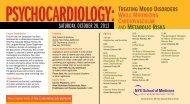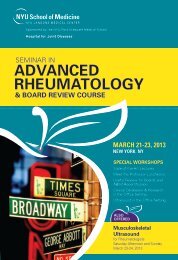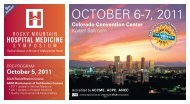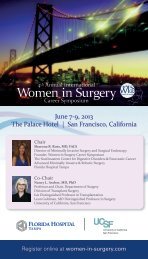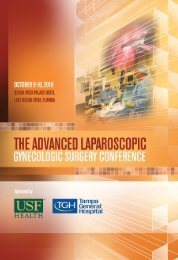38th Annual Comprehensive Review Of Physical Medicine And
38th Annual Comprehensive Review Of Physical Medicine And
38th Annual Comprehensive Review Of Physical Medicine And
You also want an ePaper? Increase the reach of your titles
YUMPU automatically turns print PDFs into web optimized ePapers that Google loves.
<strong>38th</strong> AnnuAl CoMPRehenSive <strong>Review</strong> of<br />
<strong>Physical</strong> <strong>Medicine</strong> and Rehabilitation<br />
CouRSe DeSCRiPtion<br />
This intensive six-day and threeevening<br />
review course is designed<br />
to examine current practices with<br />
emphasis on recent advances<br />
in the field of <strong>Physical</strong> <strong>Medicine</strong><br />
and Rehabilitation. Ample time is<br />
provided for questions throughout<br />
the course. One-on-one registrant<br />
faculty practice oral examination<br />
workshops will be available for<br />
registrants on Tuesday or Thursday<br />
evening as well as a written questions<br />
workshop on Wednesday evening.<br />
There will be a hands-on workshop<br />
on Musculoskeletal Ultrasound and<br />
Management of Spasticity, talks on<br />
the Maintenance of Certification<br />
Process and Disability Ratings, and<br />
a Special One-day Electrodiagnosis<br />
Program on Saturday.<br />
tARget AuDienCe<br />
1) Senior <strong>Physical</strong> <strong>Medicine</strong> &<br />
Rehabilitation (PM&R) Resident<br />
physicians preparing for Part I<br />
(Written) of the Board Certification<br />
Examination<br />
2) PM&R physicians in their first year<br />
of practice preparing for Part II<br />
(Oral) of the Board Certificate<br />
Examination<br />
3) Practicing PM&R physicians seeking<br />
continuing medical education<br />
and a knowledge update<br />
4) Practicing PM&R physicians preparing<br />
for their ABPM&R Maintenance<br />
of Certification Examination<br />
StAteMent of neeD<br />
An extensive needs assessment to<br />
identify professional practice gaps<br />
and educational needs of the learners<br />
was conducted by a comprehensive<br />
search of previous evaluations<br />
and outcomes measurement summaries,<br />
and AMA guidelines. It was<br />
determined that:<br />
• Electrodiagnosis is a highly<br />
technical skill and there is a lack<br />
of uniformity in how different<br />
practitioners execute it. Based on<br />
previous evaluations, there is still<br />
a need for more hands-on training<br />
with EMG, including examinations<br />
on Myopathies, Motor Neuron<br />
Disease and Radiculopathies.<br />
• Traumatic brain injury is still under<br />
recognized, and due to the wars in<br />
Iraq and Afghanistan, the incidence<br />
has increased because of better<br />
technology and equipment used<br />
by our armed forces. Separately,<br />
physiatry has expanded over the<br />
past decades to include an interest<br />
in musculoskeletal and sports<br />
medicine, including the sports<br />
related concussion. Clinicians<br />
need to be aware of diagnosis<br />
and management of cognitive,<br />
somatic, and emotional sequelae in<br />
concussed athletes.<br />
• It is now more common for<br />
physiatrists to handle spasticity<br />
management using either<br />
botulinum toxin injections or<br />
ITB pump refilling, as new data<br />
is published regarding the<br />
effectiveness of these treatments.<br />
Younger physiatrists were exposed<br />
to hands-on training with these<br />
treatment options during residency,<br />
but older clinicians were not, and<br />
need adequate hands-on training<br />
in order to properly and effectively<br />
manage their patients’ spasticity.<br />
• Physiatrists are becoming more<br />
established as the expert in the<br />
area of musculoskeletal disorders<br />
and are seeing more patients<br />
in need of treatment. There is a<br />
need for practicing physiatrists<br />
to focus on their diagnostic and<br />
treatment skills for this disorder,<br />
including understanding the<br />
importance of musculoskeletal<br />
ultrasound, including limitations<br />
and capabilities of using highresolution,<br />
real-time imaging<br />
of musculoskeletal features, for<br />
diagnostic and interventional<br />
procedures.<br />
• The AMA’s Guide to the Evaluation<br />
of Permanent Impairment Sixth<br />
Edition uses a new methodology to<br />
assess impairment and addresses<br />
past criticisms of the Guides<br />
including physician interrater and<br />
intrarater reliability, consistency<br />
between chapters, and an<br />
antiquated model of disablement.<br />
Additionally, evaluations from<br />
the last year’s program included<br />
requests on more information on<br />
impairment and disability rating<br />
scales and related management<br />
as this is an area in which some<br />
physiatrists are struggling.


